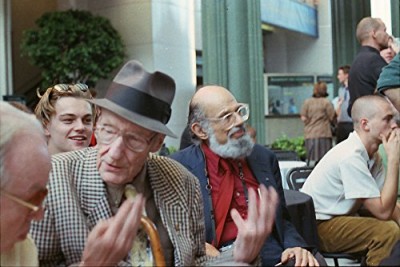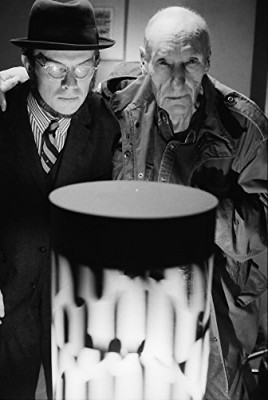| Reviews & Columns |
|
Reviews DVD TV on DVD Blu-ray 4K UHD International DVDs In Theaters Reviews by Studio Video Games Features Collector Series DVDs Easter Egg Database Interviews DVD Talk Radio Feature Articles Columns Anime Talk DVD Savant Horror DVDs The M.O.D. Squad Art House HD Talk Silent DVD
|
DVD Talk Forum |
|
|
| Resources |
|
DVD Price Search Customer Service #'s RCE Info Links |
|
Columns
|
|
|
William S. Burroughs In The Dreamachine
William S. Burroughs in the Dreamachine is Jon Aes-Nihil's experimental documentary about iconic Beat author William S. Burroughs' experiences using a stroboscopic device, known as the dreamachine, which simulates the electric pulses of the human brain to elicit hallucinations and dream-like imagery while the user's eyes are closed. Narrator Dr. David Woodard explains that Burroughs used the dream machine for inspiration as a writer. People familiar with Burroughs' writing style may understand the seemingly fragmented, sometimes incomprehensible style of the film, while those unfamiliar with the cut and paste nature of the author's work may be put off by its non-narrative structure and lo-fi aesthetic.
The film, shot on color and black and white video between 1996 and 1997, and using still images, switches locations between the Los Angeles County Museum of Art and Burroughs' home in Lawrence, Kansas. Rather than using traditional documentary formats, such as the conventional question-and-answer "talking heads" method, and giving an overview of the dream machine that uses anecdotes of Nostradamus using dream visions, the device is rarely discussed in a didactic or straightforward way. In the Dreamachine is often lingering, full of simple observations, and occasionally mystifying. There are many long, uninterrupted shots and fly-on-the-wall moments that becomes indicative of the documentary's overall approach.

The most interesting moments take place in Burroughs' Kansas home in 1997, just months before his death. Here, he spends time with Woodard, who helped re-popularize the dreamachine device in the mid-1990s. In this section of the film we see the dreamachine in use, interspersed with meandering conversations between Woodward and Burroughs about drugs, dreams, guns, government policy, and other topics that are seemingly unrelated. The only part of the film that addresses the dreamachine in any conventional way, occurs when we are shown how Dr. Woodard builds the device by hand, which is constructed from a spinning cylindrical device lit from within, with holes cut into it that rests on a turntable.
William S. Burroughs in the Dreamachine works quite well in its own peculiar way. The film counters some of the wrongly held assumptions that consumer-level video footage is unable to achieve aesthetic beauty. During scenes in Burroughs' house, in which he and Woodard use the dreamachine, the camera simply lingers on them for long moments as they lean forward, close their eyes, and sit in the device's flickering, rotating light. While watching footage of the dreamachine in the film as it's being used, the device's spinning center emits a strobing light on screen, creating the kind of dreamy effect that may actually occur when the device is used in person. The effect of the whirling spots of light that dance on screen, and on the insides of the viewer's eyelids, resemble a low-grade acid trip, or some particularly weak Ecstasy. In the tradition of non-narrative experimental filmmakers like Stan Brakhage, the light from the dream machine dances across the screen and creates hallucinatory, luminous, abstract moving forms that affirm the notion that cinema is a medium of beaming, glittering light, which, simply by itself, can be used for its own artistic gains.
Over many scenes in the documentary plays traditional Moroccan music, which alludes to the influence of Morocco on Burroughs' best-known novel, Naked Lunch. The music becomes a motif throughout the film that draws its exploration of dreams and the subconscious back to Burroughs fascination with that particular country. It is in the small moments filmed inside Burroughs' house while the dream machine is in use that the film seems directly informed by the author's written work, and where we get a true sense his personal aesthetic.

The Dreamachine connects the device to Burroughs' preoccupations with dreams and it's use as inspiration for his writing. The film itself, with its odd imagery and its disconnected, sometimes cryptic moments, resembles a particularly weird dream with its visually stunning moments of rotating, pulsating light. However, other, completely different films deal with the nature of the subconscious in more interesting ways. The films of David Lynch or Luis Bunuel provide more insight, and visually arresting images, when it comes to delving into dream worlds and how dreamstates affect people. Although it seems unfair to compare the genius of Lynch and Bunuel to Aes-Nihi's low-budget, video-shot documentary, the comparison to these filmmakers is useful because, for viewers whose interest in dream states and the alterability of the subconscious is piqued by In the Dream Machine, the films of Bunel and Lynch are good works to explore next after watching Burroughs' and Woodward's slight meditation on the subject.
The DVD
Video
William S. Burroughs in the Dreamachine's transfer to DVD is surprisingly sharp and without any distortion or noticeable digital artifacts. The image is pristine for a film that was shot on analogue video, with a full frame 1.33:1 aspect ratio. The lo-fi quality of the image works in the film's favor, giving it an intimate feel, as though it were a hand-made piece of experimental art. The use of a cheap-looking title generator for the beginning and end credits also contributes to this experimental look. The use of low-tech equipment and editing software for the documentary proves that filmmakers who use the few tools at their disposal are able to use the limits placed on them to their advantage.
Sound
The DVD has a Dolby track, with the audio spread out evenly over when played on stereo speakers. The voice-over narration heard occasionally in the film sounds as though it were recorded on professional equipment, but the location sound was obviously recorded in-camera. Regardless of the use of an in-camera microphone, the audio is clean, if somewhat muffled in certain parts. There is also quite a bit of ambient sound that is mixed with certain subjects speaking, which doesn't necessarily detract from the film. Like most of the lo-tech aspects of the movie and the disc, the lack of professional equipment works in its favor, in a peculiar way. There are no subtitles, so there is no way to understand the parts of the audio that are muffled, or drowned out by background noise. Perhaps the audio had to be cleaned-up and retweaked in parts of the film where the in-camera sound was inaudible.
Extras
Included in the extras as a still photo montage of Burroughs, Allen Ginsberg, and a handful of people who appeared in the documentary, set to traditional Moroccan music and a videotaped 2007 art installation by David Woodard at the Freud Museum of Dreams in St. Petersburg, Russia.
The few extras that are included on the disc repeat some of the elements that are already present in the film. Some of the still photos make their way into the documentary, as does the narration that Woodard reads into a microphone at the installation in St. Petersburg, where a group of spectators stand around a dreamachine in a darkened gallery and listen to Woodard read, word-for-word, his narration from the film. The video from the installation is nearly an hour long, and may even test the patience of people who watched the entire feature because of its redundancy. The inclusion of these two extra features do little to deepen the viewer's understanding of the film, but they may appeal to Burroughs fans who want to dig into every possible aspect of his life and work.
Final Thoughts
William S. Burroughs in the Dreamachine will appeal mostly to those who already have a strong understanding of Burroughs' writing style and artistic sensibility. The film is watchable in its own peculiar way because of the analogue VHS aesthetic that allows for interesting, perhaps unintentional, formal flourishes involving the light omitted from the dreamachine.
|
| Popular Reviews |
| Sponsored Links |
|
|
| Sponsored Links |
|
|
| Release List | Reviews | Shop | Newsletter | Forum | DVD Giveaways | Blu-Ray | Advertise |
|
Copyright 2024 DVDTalk.com All Rights Reserved. Legal Info, Privacy Policy, Terms of Use,
Manage Preferences,
Your Privacy Choices | |||||||












